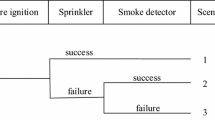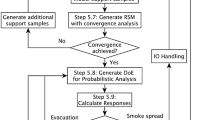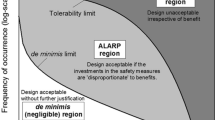Abstract
In many cases, the principle goal of a fire safety engineering (FSE) design is the life safety of the users of a structure. There are, however, other potential fire safety goals to consider, e.g., property protection, continuity of operations, protection of the environment and protection of cultural heritage [1]. Whatever the goal, users of the building, both building managers and occupants, will have a role in its achievement.
Access this chapter
Tax calculation will be finalised at checkout
Purchases are for personal use only
Similar content being viewed by others
References
Watts, J.M. (2008). Systems Approach to Fire-Safe Building Design, NFPA Handbook (20th ed), 1–159.
ISO/TS 16733:2006 – Selection of design fire scenarios and design fires (2006) Geneva: ISO.
BBRAD 1 - Boverkets allmänna råd om analytisk dimensionering av byggnaders brandskydd, BFS 2011:26 med ändringar t.o.m. BFS 2012:13 (2011) Karlskrona: Boverket.
INSTA/prTS 950 - Fire Safety Engineering - Verification of fire safety design in buildings (2013) Inter Nordic Standardisation Organisation
Frantzich, H. (1998). Uncertainty and Risk Analysis in Fire Safety Engineering. Report 1016, Lund: Department of Fire Safety Engineering, Lund University.
Paté-Cornell, M. E. (1996). Uncertainties in risk analysis: six levels of treatment. Reliability Engineering and Systems Safety, 54(2), 95–111.
Sime, J.D. (1985). Movement towards the familiar - Person and place affiliation in a fire entrapment setting. Environment and Behaviour, 17(6), 697–724.
SFPE (2007) SFPE Engineering Guide to Performance-Based Design (2nd ed.). Bethesda, MD: Society of Fire Protection Engineers.
BBR19 - Regelsamling för byggande, Boverkets byggregler, BFS 2011:6 med ändringar t.o.m. BFS 2011:26 (2011) Karlskrona: Boverket.
NFPA 101: Life Safety Code® (2012). Quincy, MA: National Fire Protection Association.
NKB (1994). Funktionsbestemte brandkrav og teknisk vejledning for beregningsmeassig eftervisning, NKB Utskotts- och arbetsrapporter 1994:07, Helsinki: NKB.
ISO/TS 13571:2002 - Life-threatening components of fire - Guidelines for the estimation of time available for escape using fire data. (2002) Geneva: ISO.
van Hees, P., Nilsson, D., & Berggren, E. (2009). Simulation of critical evacuation conditions for a fire scenario involving cables and comparison of two different cables. Lund: Department of Fire Safety Engineering and Systems Safety, Lund University.
Gwynne, S., Kuligowski, E., & Nilsson, D. (2012). Representing Evacuation Behaviour in Engineering Terms. Journal of Fire Protection Engineering, 22(2), 133–150.
Nilsson, D. (2009). Exit choice in fire emergencies - Influencing choice of exit with flashing lights, Report 1040, Lund: Department of Fire Safety Engineering and Systems Safety, Lund University.
McClintock, T., Shields, T.J., Reinhardt-Rutland, A.H., & Leslie, J.C. (2001). A behavioural solution to the learned irrelevance of emergency exit signage. Proceedings of the 2 nd International Symposium on Human Behaviour in Fire, London, UK, pp. 23–33.
Bruck D. & Brennan P. (2001). Recognition of fire cues during sleep. Proceedings of the 2 nd International Symposium on Human Behaviour in Fire, London, UK, pp. 241–252.
Ball, M., & Bruck, D. (2004). The effect of alcohol upon response to different fire alarm signals in sleeping young adults. Proceedings of the 3 rd International Symposium on Human Behaviour in Fire, Belfast, UK, pp. 291–302.
Anderson, B.M., Stevens, M.C, Meda, S.A., Jordan K., Calhoun, V.D., & Pearlson, G.D. (2010). Functional Imaging of Cognitive Control During Acute Alcohol Intoxication, Alcoholism: Clinical & Experimental Research; DOI: 10.1111/j.1530-0277.2010.01332.x.
Latané, B.,& Darley, J.M. (1968). Group Inhibition of Bystander Intervention in Emergencies, Journal of Personality and Social Psychology, 10(3), 215–221.
Swartz, J.A. (1979). Human Behavior in the Beverly Hills Fire. Fire Journal, 73(3), 73–74, 108.
Drysdale, D. (2011). An Introduction to Fire Dynamics.(3rd ed.) West Sussex: John Wiley & Sons, Ltd.
Ingason, H., Kumm, M., Nilsson, D., Lönnermark, A., Claesson, A., Li, Y.Z., Fridolf, K., Åkerstedt, R., Nyman, H., Dittmer, T., Forsén, R., Janzon, B., Meyer, G., Bryntse, A., Carlberg, T., Newlove-Eriksson. L., Palm, A. (2012). The METRO project - Final report. SiST 2012:8, Västerås: School of Sustainable Development of Society and Technology, Mälardalen University.
Sekizawa, A., Ebihara, M., & Notake, H. (2003). Development of Seismic-induced Fire Risk Assessment Method for a Building. Fire Safety Science – Proceedings of the 7 th International Symposium, International Association for Fire Safety Science, pp. 309–320.
Kim, J.K., Park, H. & Meacham, B.J. (2013). “Fire Performance of Earthquake-Damaged Buildings: Overview and Preliminary Analysis of Full-Building Earthquake and Fire Tests,” Proceedings, Interflam 2013, Interscience Communication, Ltd., London, UK, 1407–1418.
Hamby, D.M. (1995). A Comparison of Sensitivity Analysis Techniques. Health Physics, 68(2), 195–204.
Levin, B.M. (1984). Human Behavior in Fire: What We Know Now. SFPE Technology Report 84–3, Boston, MA: Society of Fire Protection Engineers.
Purser, D.A. and Bensilum, M. (2001). Quantification of behaviour for engineering design standards and escape time calculations, Safety Science, 38, 157–182.
Harne (1998). Polisen utan spår efter pyromanen [Police without any trace after pyromaniac], Aftonbladet, 24th December, 1998.
Author information
Authors and Affiliations
Editor information
Editors and Affiliations
Rights and permissions
Copyright information
© 2016 Society of Fire Protection Engineers
About this chapter
Cite this chapter
Nilsson, D., Fahy, R. (2016). Selecting Scenarios for Deterministic Fire Safety Engineering Analysis: Life Safety for Occupants. In: Hurley, M.J., et al. SFPE Handbook of Fire Protection Engineering. Springer, New York, NY. https://doi.org/10.1007/978-1-4939-2565-0_57
Download citation
DOI: https://doi.org/10.1007/978-1-4939-2565-0_57
Publisher Name: Springer, New York, NY
Print ISBN: 978-1-4939-2564-3
Online ISBN: 978-1-4939-2565-0
eBook Packages: EngineeringEngineering (R0)




